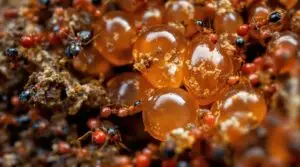The insect growth regulator fenoxycarb greatly affects the ovaries of queen red imported fire ants by disrupting hormonal signaling, which impairs reproductive health. This disruption leads to abnormal ovarian development, reduced egg production, and compromised colony dynamics. Researchers find that altered hormone levels due to fenoxycarb affect queen fertility and overall colony success, emphasizing the importance of queen reproductive health for colony sustainability. Discoveries in this area reveal critical insights into the broader ecological impacts of such chemicals.
Fire Ant Control: Targeting the Queen for Lasting Relief
Want to effectively disrupt fire ant colonies and reclaim your Homestead yard? Contact NaturePest Holistic Pest Control today! We use advanced, eco-friendly strategies that focus on the root of the problem, giving you lasting relief and a healthier outdoor space.
Key Insights
- Fenoxycarb mimics juvenile hormones, disrupting normal ovarian development in queen fire ants and leading to reduced egg-laying capabilities.
- Exposure to fenoxycarb results in structural changes in ovaries, decreasing the number of ovarioles and overall reproductive potential.
- The treatment leads to hormonal disruptions, impairing reproductive health and altering gene expression related to fertility in queen ants.
- Fenoxycarb exposure can increase competition among queens and disrupt colony dynamics due to reduced reproduction rates and altered behaviors.
- Assessing ovarian health through histological techniques reveals significant abnormalities in oocyte development following fenoxycarb exposure in queen fire ants.
Overview of Insect Growth Regulators
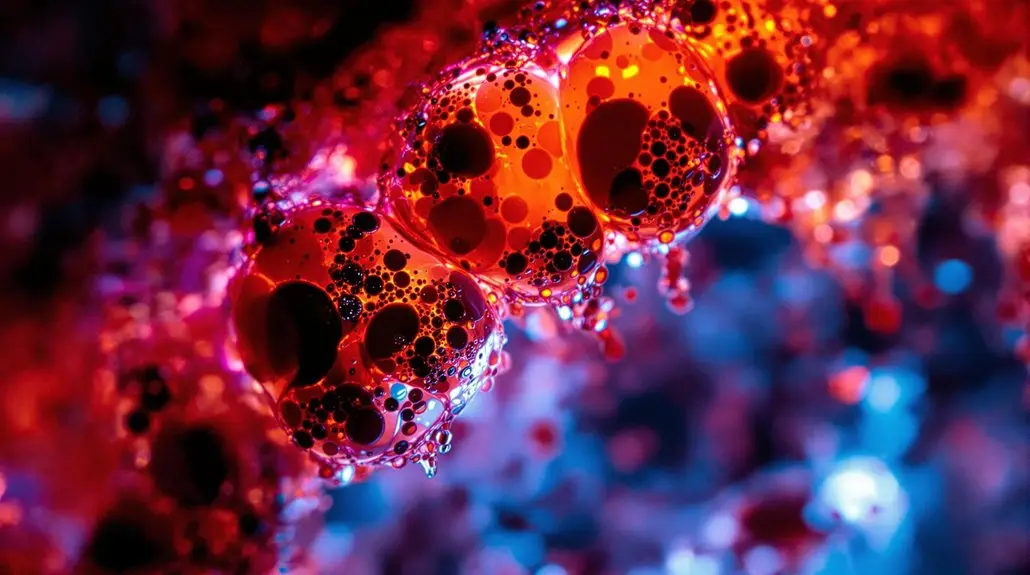
Insect growth regulators (IGRs) play an essential role in managing pest populations by interfering with the normal developmental processes of insects, which is important for understanding their implications in agriculture and pest control.
IGRs function primarily by mimicking hormones or disrupting the hormone signaling pathways that govern insect growth and reproduction. These substances are particularly valuable because they target specific developmental stages, often preventing larvae from maturing into adults, thereby reducing the overall population.
Unlike traditional insecticides, IGRs tend to be less harmful to beneficial insects, making them an environmentally friendly option for pest management. They can be applied in various agricultural settings, contributing to sustainable practices.
Mechanism of Action of Fenoxycarb
Fenoxycarb, a widely studied insect growth regulator, demonstrates its effectiveness by specifically targeting the hormonal processes that control insect development. By mimicking the natural hormones in insects, it disrupts the normal signaling pathways responsible for growth and reproduction.
When you apply Fenoxycarb, it interferes with the synthesis of juvenile hormones, which are essential for maintaining the larval state and preventing premature metamorphosis. This disruption leads to abnormal development, resulting in sterility or reduced fertility in affected insects.
In particular, the impact on reproductive hormones influences ovarian development, causing significant changes in queen ants. Researchers have noted that as these hormonal processes become altered, you may observe a decline in egg production and overall colony health.
Understanding Fenoxycarb’s mechanism of action not only sheds light on its effectiveness as an insect growth regulator but also highlights its potential implications for managing pest populations in various environments.
Target Species: Red Imported Fire Ant
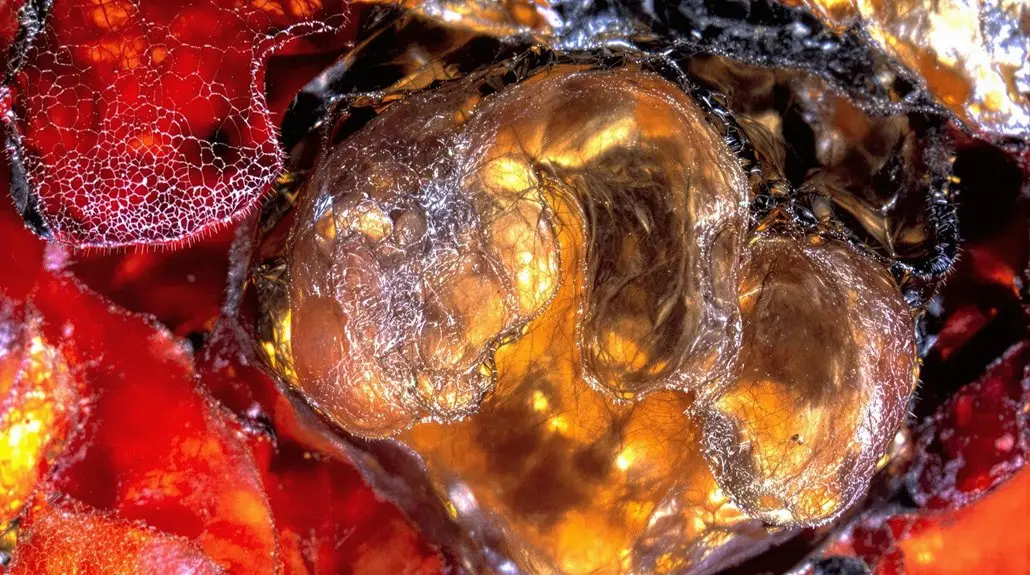
When evaluating the impact of fenoxycarb on red imported fire ant queens, it’s essential to understand both the reproductive effects and the specific mechanism by which fenoxycarb influences their biology.
You’ll find that this insect growth regulator disrupts the normal hormonal processes, leading to potential declines in queen fertility and overall colony success.
Reproductive Impact Assessment
As researchers evaluate the reproductive impact of various substances on target species, understanding how chemicals influence the biology of organisms like the red imported fire ant (Solenopsis invicta) becomes essential.
In examining the reproductive effects of fenoxycarb on these ants, it’s vital to scrutinize parameters such as ovarian development, egg production, and overall reproductive fitness.
Studies reveal that exposure to fenoxycarb can potentially disrupt normal reproductive processes in queen ants, leading to reduced egg-laying capabilities and impaired development of offspring.
By meticulously analyzing these impacts, researchers can better appreciate the broader ecological consequences that arise from the use of insect growth regulators.
This knowledge not only contributes to pest management strategies but also promotes a deeper understanding of insect biology and ecology.
Fenoxycarb Mechanism of Action
Understanding how fenoxycarb interacts with the biology of red imported fire ants reveals crucial insights into its mechanism of action. This insect growth regulator mimics the natural hormones that regulate development and reproduction in insects, specifically targeting the juvenile hormone.
By disrupting the normal hormonal balance, fenoxycarb inhibits the maturation of larvae and alters the reproductive capabilities of queen ants. As a result, you can observe a decrease in egg production and the overall vitality of the colony.
Additionally, fenoxycarb’s persistence in the environment allows it to exert prolonged effects, leading to a significant impact on population dynamics. This understanding enables researchers to devise effective pest control strategies that minimize harm to non-target organisms while efficiently managing fire ant populations.
Life Cycle of the Red Imported Fire Ant
The life cycle of the red imported fire ant, Solenopsis invicta, comprises several distinct stages, each playing a vital role in the colony’s development and sustainability.
It begins with the mating flight, where winged males and females emerge, mate, and then the fertilized queens land, shedding their wings to establish new nests.
After laying eggs, the queen undergoes a phase of intense care for her brood, where she feeds and protects them until they mature into worker ants.
These workers take over foraging, nest maintenance, and brood care while the queen focuses on reproduction.
The cycle continues as the colony grows; new queens are produced, ensuring future generations.
Environmental factors, such as temperature and food availability, influence the timing and success of each stage.
Understanding this life cycle is essential for researchers studying the impacts of various substances, including insect growth regulators like fenoxycarb, on colony health and dynamics.
Importance of Queen Reproductive Health
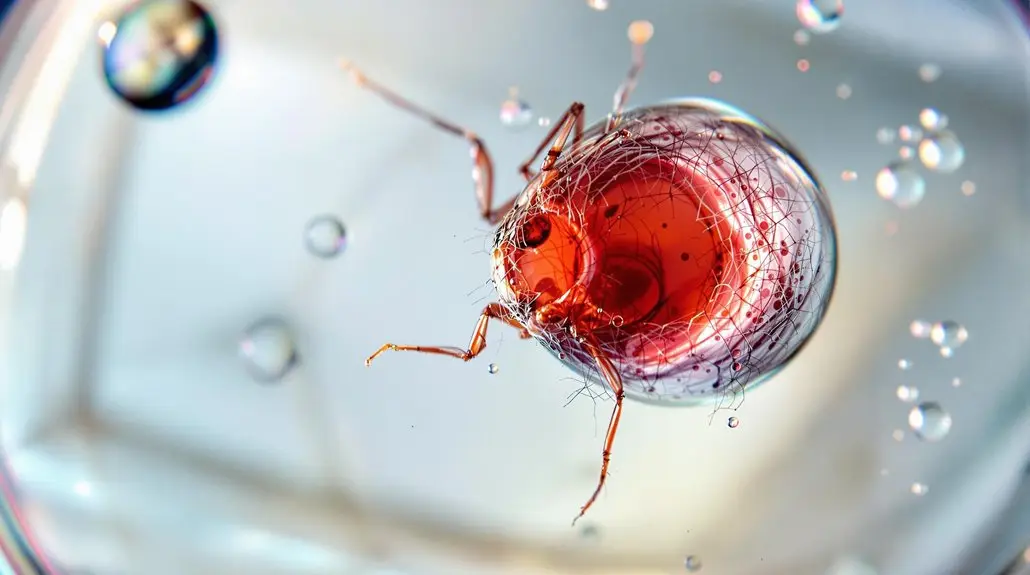
Understanding the reproductive health of fire ant queens is essential for the overall success of their colonies, as it directly influences their ability to produce new workers and sustain population growth.
Healthy queens contribute to genetic diversity within the colony, which can enhance resilience against environmental stressors and improve adaptability to changing conditions.
Consequently, researchers must examine factors affecting queen health, as their findings could have significant implications for fire ant management and ecology.
Role in Colony Success
Queen reproductive health plays a pivotal role in the success of Red Imported Fire Ant colonies, as it directly influences the growth and sustainability of the colony itself.
Healthy queens produce a sufficient number of eggs, which guarantees a thriving workforce to maintain colony activities, from foraging to defense. When queens face reproductive challenges, such as hormonal disruptions from substances like Fenoxycarb, the number of viable offspring decreases, ultimately jeopardizing the colony’s survival.
Additionally, a robust queen can enhance colony resilience against environmental stressors, fostering a cohesive community that supports one another.
Consequently, maintaining queen health is essential not only for immediate reproductive success but also for the long-term stability and prosperity of the entire colony.
Genetic Diversity Implications
While maintaining a healthy reproductive capacity is essential for Red Imported Fire Ant queens, the implications of their genetic diversity extend far beyond individual health; it shapes the entire colony’s adaptability and resilience.
Genetic diversity among queens guarantees that a broader range of traits is available for selection, which can enhance the population’s ability to respond to environmental changes and disease pressures.
When queens are compromised, as can happen with exposure to substances like Fenoxycarb, reproductive success may decline, leading to reduced genetic variability.
This reduction can ultimately weaken the colony, making it less capable of thriving in varying conditions.
Therefore, protecting queen reproductive health is critical not only for individual queens but also for maintaining the liveliness of the entire colony.
Environmental Stress Factors
As environmental stress factors increasingly threaten the reproductive health of Red Imported Fire Ant queens, it becomes essential to examine the various elements that can impact their ability to reproduce effectively.
Factors such as temperature fluctuations, habitat destruction, and pesticide exposure can considerably disrupt the delicate balance required for ideal queen fertility. These stressors may lead to reduced egg production, compromised ovarian health, and ultimately, colony decline.
Furthermore, when queens face multiple stressors simultaneously, their reproductive capabilities may be further hindered. Understanding these environmental challenges is critical for both researchers and pest management professionals, as it allows for the development of strategies to mitigate their effects.
Prioritizing queen health is fundamental for ensuring the survival and stability of Red Imported Fire Ant populations.
Effects of Fenoxycarb on Insect Development
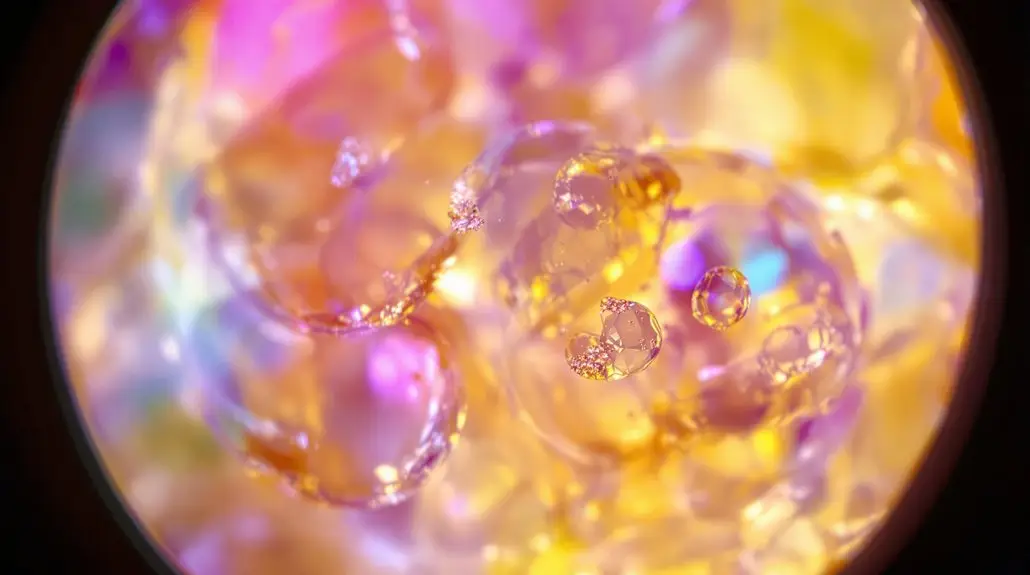
Understanding the effects of Fenoxycarb on insect development is essential, particularly given its role as a juvenile hormone analog that disrupts normal growth patterns in various species. This compound affects development stages, leading to altered behavior and morphology. Researchers have documented notable changes in growth rates and reproduction, which can considerably impact insect populations.
| Developmental Stage | Normal Hormonal Activity | Effects of Fenoxycarb |
|---|---|---|
| Egg | Hormonal regulation | Delayed hatching |
| Larva | Growth promotion | Stunted growth |
| Pupa | Transformation | Abnormal development |
| Adult | Reproductive maturity | Reduced fertility |
| Queen | Colony establishment | Impaired egg-laying |
These findings highlight the importance of understanding Fenoxycarb’s effects, as they provide insight into managing insect populations and potential ecological consequences. By studying these effects, researchers contribute to a deeper understanding of insect biology and pest management strategies.
Impact on Queen Ovarian Structure
The impact of Fenoxycarb on the ovarian structure of red imported fire ant queens is considerable, as this compound can lead to alterations in reproductive anatomy and function.
Research indicates that exposure to Fenoxycarb may result in structural changes within the ovaries, potentially affecting egg development and maturation. Specifically, the number of ovarioles, which are essential for producing eggs, may decrease, thereby limiting the queen’s reproductive potential.
Additionally, the overall size of the ovaries might also be affected, reflecting a shift in the queen’s ability to produce viable offspring. These changes highlight the importance of understanding how insect growth regulators, like Fenoxycarb, can disrupt normal reproductive processes.
Hormonal Changes Induced by Fenoxycarb

When you examine the hormonal changes induced by Fenoxycarb in red imported fire ant queens, it’s essential to contemplate how this insect growth regulator disrupts normal hormonal signaling.
Researchers have found that Fenoxycarb influences the endocrine system, leading to alterations in reproductive health that can markedly impact the queens’ ability to produce viable offspring.
Understanding these mechanisms not only reveals the potency of Fenoxycarb but also highlights the broader implications for ant population dynamics and ecosystem balance.
Hormonal Disruption Mechanisms
Although research on hormonal disruption mechanisms induced by Fenoxycarb remains ongoing, evidence suggests that this compound considerably alters the hormonal balance in red imported fire ant queens, leading to various physiological changes.
You might find it enlightening to reflect on the ways in which Fenoxycarb affects these queens:
- It mimics natural hormones, disrupting normal signaling.
- It inhibits the synthesis of essential hormones, leading to imbalances.
- It alters gene expression related to hormone regulation, impacting development.
- It can interfere with reproductive hormone pathways, affecting overall health.
These mechanisms highlight the intricate interactions between Fenoxycarb and the hormonal systems of fire ant queens, illustrating the potential consequences of chemical exposure on the hormonal landscape in this species.
Understanding these disruptions is vital for comprehending their broader ecological impact.
Impact on Reproductive Health
Research indicates that hormonal changes induced by Fenoxycarb greatly impact the reproductive health of red imported fire ant queens. These changes can lead to decreased egg production and alter the overall reproductive capacity of the queens, affecting colony dynamics. Understanding these effects is essential, as it highlights the potential ecological consequences of using such insect growth regulators.
| Effect | Description |
|---|---|
| Egg Production | Reduction in the number of eggs |
| Fertility Rate | Decreased likelihood of fertilization |
| Hormonal Imbalance | Disruption of reproductive hormones |
| Colony Growth | Impaired growth and sustainability |
| Long-term Viability | Threat to future generations |
Consequences for Colony Dynamics
Understanding the effects of Fenoxycarb on red imported fire ant queens is essential, as this insect growth regulator can considerably alter colony dynamics.
The introduction of Fenoxycarb may lead to significant changes within the colony, affecting not just the queens but the entire social structure. You might observe:
- Reduced reproduction rates, resulting in fewer new workers to sustain the colony.
- Altered foraging behaviors, as worker ants may shift their focus to different tasks, impacting food availability.
- Increased competition among remaining queens, which can lead to aggressive behaviors and colony instability.
- Changes in colony communication, as pheromone production may decline, disrupting the cohesiveness of the group.
These consequences underline the importance of monitoring Fenoxycarb’s impact, as they can ultimately disrupt the delicate balance that keeps a colony thriving.
Understanding these dynamics helps foster a deeper appreciation for the intricacies of fire ant societies.
Comparative Studies With Other IGRS
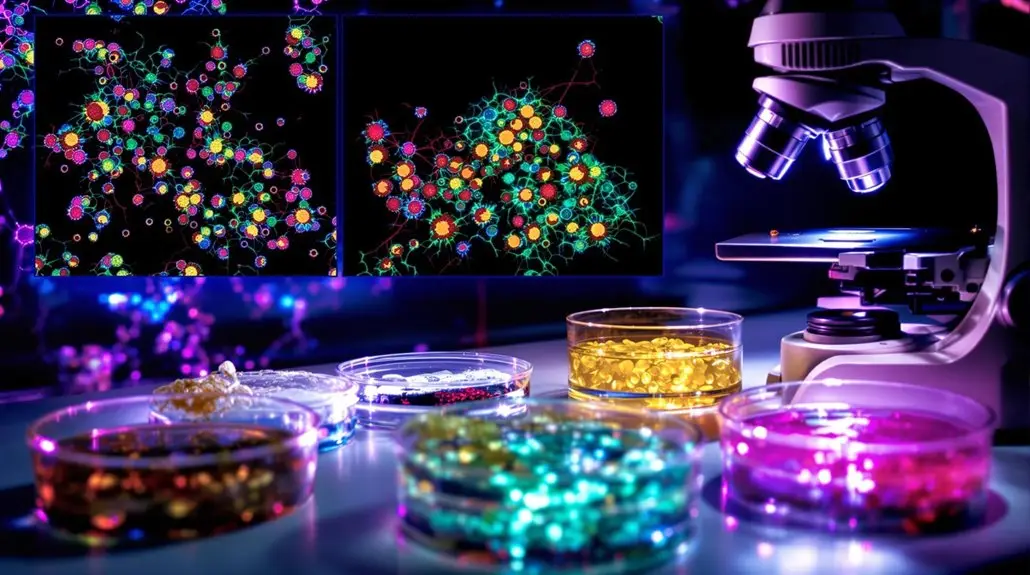
When examining the effects of insect growth regulators (IGRs) like Fenoxycarb on red imported fire ant queens, it’s essential to compare these findings with those of other IGRs to gain a detailed understanding of their overall impact.
Research indicates that different IGRs, such as Methoprene and Pyriproxyfen, exhibit varying effects on queen fertility and colony dynamics, which can greatly influence ant population control strategies.
For instance, while Fenoxycarb primarily disrupts ovarian development, Methoprene may impair the maturation of ant larvae, leading to reduced worker populations.
This divergence in effects underscores the need for extensive studies that assess how each IGR interacts with the unique biology of red imported fire ants.
Non-target Effects on Ecosystems
The impact of insect growth regulators (IGRs) like Fenoxycarb extends beyond the targeted red imported fire ant populations, raising concerns about potential non-target effects on surrounding ecosystems.
When you think about these effects, consider how IGRs can inadvertently alter the balance of local ecosystems in several ways:
- Disruption of Pollinator Populations: Non-target insects, such as bees and butterflies, may be affected, leading to reduced pollination.
- Food Web Alterations: The reduction in ant populations can impact species that rely on them for food, causing cascading effects.
- Soil Health: Changes in ant behavior may affect soil aeration and nutrient cycling, essential for plant health.
- Biodiversity Loss: The potential decline of various insect species could lead to decreased biodiversity, affecting overall ecosystem resilience.
Furthermore, the use of IGRs may pose risks of harmful chemical exposure to non-target organisms, contributing to the broader ecological impact.
Methodology for Assessing Ovarian Health
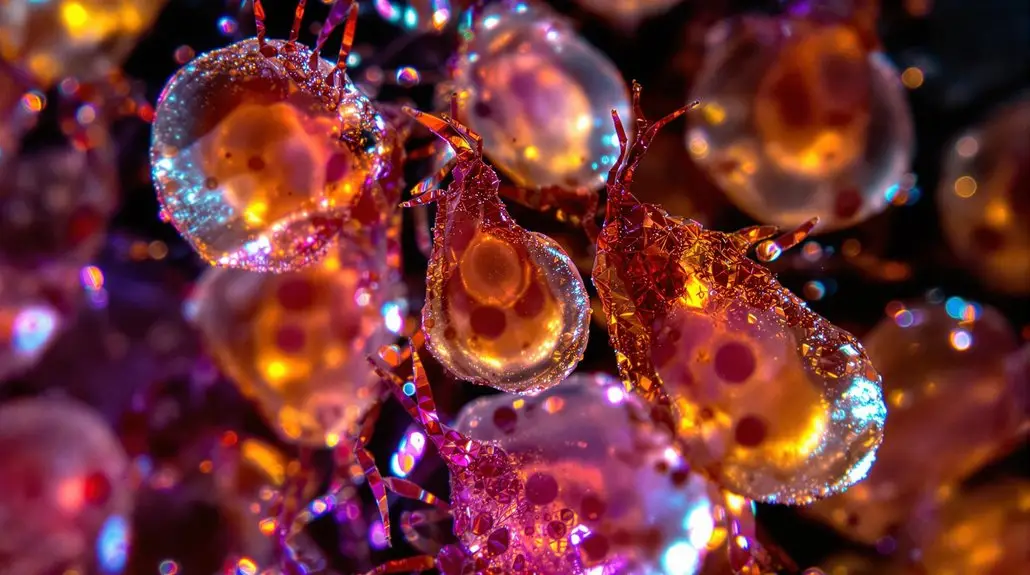
Several methodologies exist for evaluating ovarian health in red imported fire ant queens, each designed to provide insights into reproductive capabilities and overall significance.
Researchers typically employ histological techniques, where they meticulously examine ovarian tissue samples under a microscope to assess cellular structures and developmental stages. This approach allows for the identification of healthy oocytes and the presence of any abnormalities.
Additionally, researchers might utilize physiological assessments, measuring hormone levels that play a vital role in reproduction. These hormone analyses can reveal insights into the queens’ reproductive status and potential fertility.
Another method involves behavioral observations, as the queens’ mating behavior can indicate ovarian health indirectly.
Implications for Pest Management Strategies
Understanding the impact of fenoxycarb on ovarian health in red imported fire ant queens can profoundly influence pest management strategies.
By recognizing how this insect growth regulator affects queen reproduction, you can adopt more effective control measures.
Consider these implications:
- Targeted Application: You can apply fenoxycarb strategically during critical reproductive periods to maximize its effectiveness against fire ant populations.
- Reduced Populations: By disrupting queen fertility, you can greatly decrease future worker ant numbers, leading to a more manageable infestation.
- Sustainable Practices: Incorporating fenoxycarb into an integrated pest management plan can reduce reliance on harsher chemicals, promoting environmental sustainability.
- Monitoring and Evaluation: Regularly monitoring queen health and reproductive rates will help refine your strategies, ensuring they remain effective over time.
Additionally, using eco-friendly solutions for pest control ensures that your strategies align with environmentally-conscious practices.
Future Research Directions
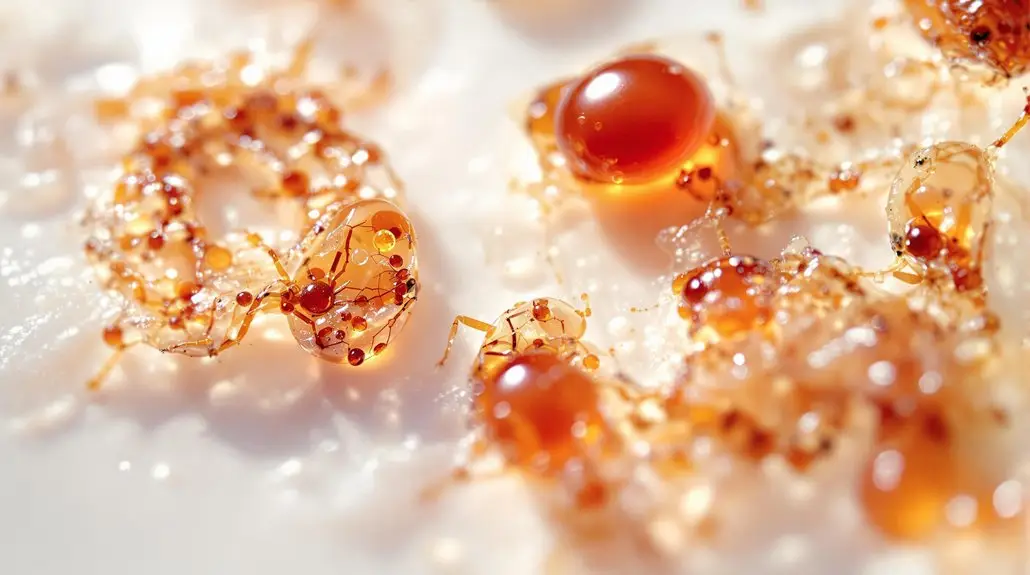
As we consider future research directions regarding the effects of Fenoxycarb on red imported fire ant queens, it’s essential to focus on the long-term ecological impact of this insect growth regulator.
Understanding the mechanisms of action will provide insights into its effectiveness and potential side effects, while exploring alternative insect growth regulators could offer additional strategies for managing these pests.
Long-term Ecological Impact
While the immediate effects of Fenoxycarb on red imported fire ant queens have been documented, understanding the long-term ecological impacts requires further investigation into how these interventions may alter population dynamics and ecosystem interactions over time.
Researchers should focus on several key areas to fully grasp these effects:
- Population Structure: How does Fenoxycarb influence the genetic diversity and reproductive rates of fire ant colonies?
- Predator-Prey Relationships: Are there shifts in the behavior or populations of species that prey on fire ants?
- Competing Species: Will other ant species flourish or decline as a result of altered fire ant populations?
- Ecosystem Health: How does the presence of Fenoxycarb affect soil quality and native plant life?
Mechanisms of Action
Exploring the mechanisms of action of Fenoxycarb on red imported fire ant queens is essential for developing effective pest management strategies, since this insect growth regulator disrupts the normal hormonal processes within the ants’ development.
Researchers believe that Fenoxycarb mimics juvenile hormones, leading to abnormalities in reproductive organ development and egg production. These hormonal disruptions can affect crucial processes such as ovary maturation and the overall reproductive success of the queens.
Understanding these mechanisms won’t only clarify how Fenoxycarb affects ant populations but also guide future research in optimizing its application and exploring potential resistance issues.
Alternative Insect Growth Regulators
Identifying alternative insect growth regulators (IGRs) is essential for advancing pest management strategies against red imported fire ants, especially as researchers seek to mitigate the limitations and potential resistance associated with Fenoxycarb.
Exploring new IGRs can lead to effective solutions, fostering a sense of community among those affected.
Consider these promising options:
- Methoprene – A juvenile hormone analog that disrupts normal development.
- Pyriproxyfen – Another juvenile hormone mimic, it affects reproduction and growth.
- Buprofezin – Inhibits chitin synthesis, leading to abnormal exoskeleton formation.
- Diflubenzuron – Blocks chitin production, impacting molting and growth.
Recommendations for Responsible Use of IGRs
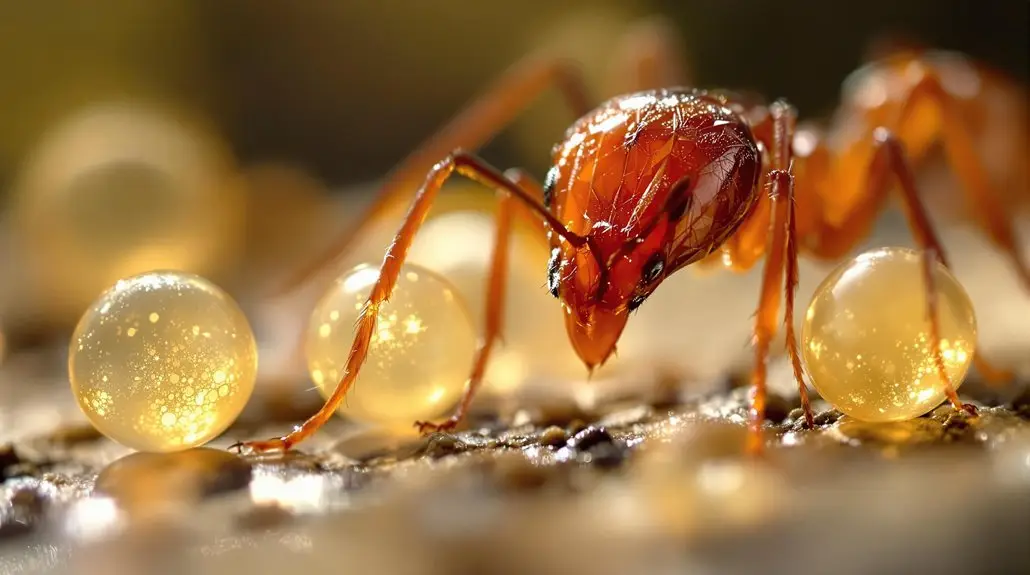
To guarantee the effective and responsible use of insect growth regulators (IGRs) like Fenoxycarb, it is essential to follow specific guidelines that minimize potential risks to non-target species and the environment. You can contribute to responsible usage by considering the following recommendations:
| Guideline | Description |
|---|---|
| Read Labels | Always read product labels for specific instructions and precautionary information. |
| Target Application | Apply IGRs only to areas where target pests are present to reduce non-target exposure. |
| Timing of Application | Use IGRs during ideal times for pest activity to enhance effectiveness. |
| Monitor Effects | Observe the environment and pest populations after application for unexpected effects. |
| Dispose Properly | Follow local regulations for disposal to prevent environmental contamination. |
Additionally, utilizing Integrated Pest Management (IPM) can help ensure that IGRs are part of a comprehensive approach to pest control that prioritizes safety and effectiveness.
Frequently Asked Questions
What Are the Signs of Fenoxycarb Exposure in Fire Ant Queens?
When fire ant queens are exposed to fenoxycarb, you might notice several signs indicating potential effects.
These include reduced egg production, abnormal ovarian development, and changes in behavior, such as decreased activity.
Researchers often observe these symptoms through careful examination of the queens’ reproductive structures and monitoring their nesting behaviors.
Are There Any Long-Term Effects of Fenoxycarb on Ant Colonies?
When it rains, it pours, and the long-term effects of fenoxycarb on ant colonies can be significant.
Research indicates that prolonged exposure may disrupt reproductive capabilities, reduce colony growth, and impact social structure. Queens may struggle to produce viable offspring, leading to dwindling populations over time.
As these changes accumulate, the entire colony’s health and survival become jeopardized, emphasizing the importance of understanding chemical impacts on ecological systems.
How Does Fenoxycarb Affect the Behavior of Fire Ant Workers?
Fenoxycarb influences the behavior of fire ant workers by disrupting their normal activities, such as foraging and brood care.
Researchers have observed that exposure to this insect growth regulator can lead to decreased worker efficiency and altered communication, which ultimately impacts colony dynamics.
These changes may result in reduced food collection and impaired colony growth, highlighting the importance of understanding how such chemicals affect social insects in both immediate and long-term contexts.
Can Fenoxycarb Impact Other Ant Species Similarly?
Imagine a garden where every ant species dances to its own rhythm, yet some tunes can be disrupted. Researchers wonder if fenoxycarb, a growth regulator, impacts other ant species similarly to how it affects fire ants.
Evidence suggests that while responses may vary, the underlying mechanisms of growth disruption could resonate across species, leading to altered behaviors and reproductive functions.
This interconnectedness among ant species highlights the broader ecological implications of chemical exposure.
What Safety Precautions Should Be Taken When Using Fenoxycarb?
When using fenoxycarb, it’s essential to follow several safety precautions to guarantee your protection and the environment’s well-being.
Always wear protective clothing, including gloves and masks, to minimize exposure.
Verify the area is well-ventilated, and avoid applying it near water sources to prevent contamination.
Read the product label for specific instructions and dosage recommendations, and store it in a secure location, out of reach of children and pets, to avoid accidental ingestion.
Final Thoughts
Implications for Pest Management Strategies
To summarize, the research on fenoxycarb’s effects on the ovaries of red imported fire ant queens demonstrates significant implications for pest management strategies. By understanding the mechanisms through which this insect growth regulator disrupts reproductive health, we can develop more effective control measures that minimize environmental impact. As researchers continue to explore the nuances of such interactions, it becomes increasingly essential to apply these findings responsibly, ensuring both effective pest management and the sustainability of ecosystems.
Unlocking Pest Control Solutions: A New Era in Eco-Friendly Management!
Take action today for a pest-free environment! Join us at NaturePest Holistic Pest Control in South Florida to discover how we can help you tackle fire ant infestations while prioritizing the health of our ecosystems. Together, we can create a balanced environment that keeps your home safe from pests without compromising our planet. Contact us now for expert solutions!

